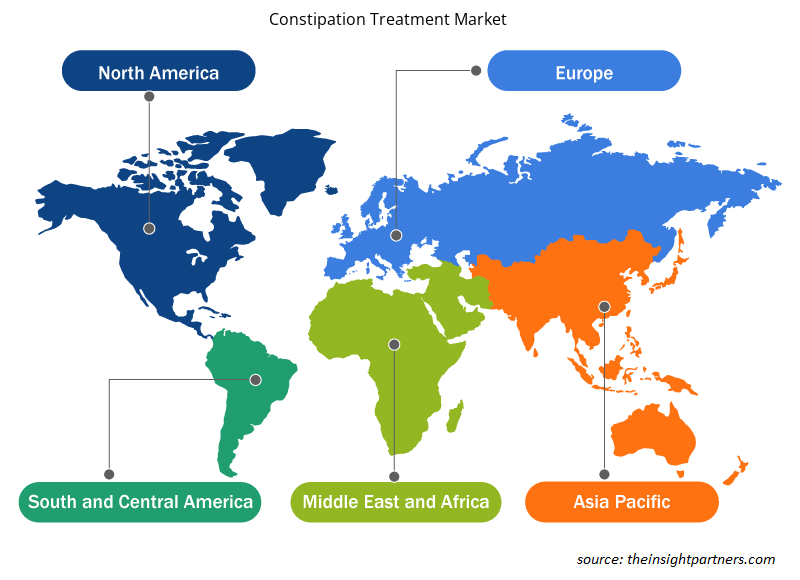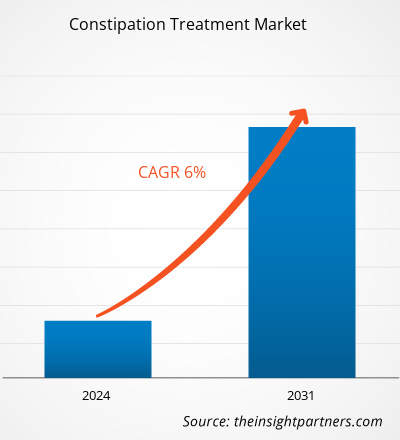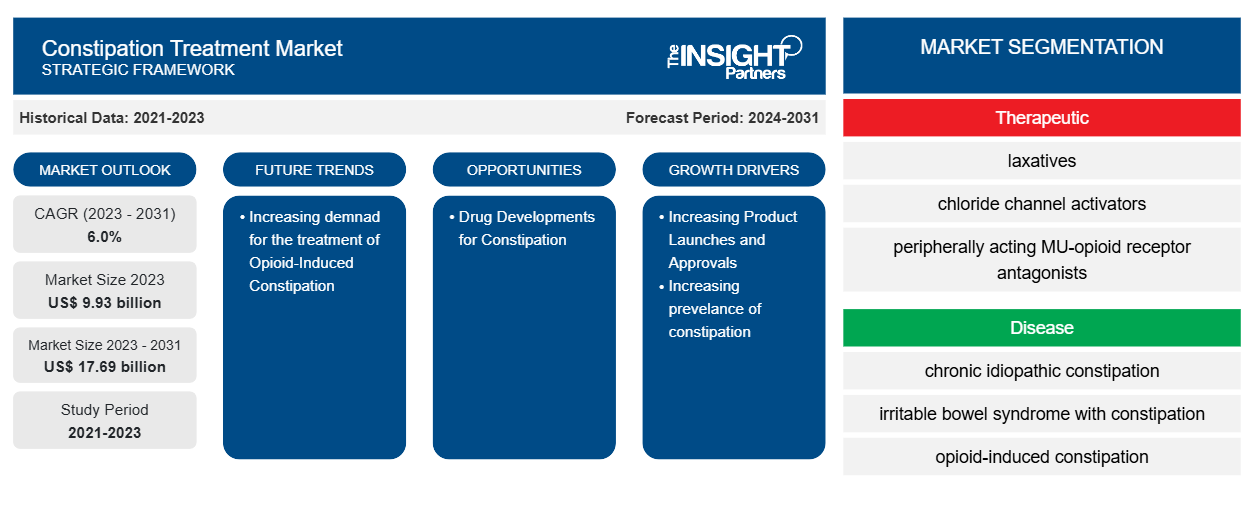Se proyecta que el tamaño del mercado de tratamiento del estreñimiento alcance los 17.690 millones de dólares estadounidenses en 2031, frente a los 9.930 millones de dólares estadounidenses en 2022. Se espera que el mercado registre una CAGR del 6,0 % entre 2023 y 2031. Es probable que la creciente demanda de tratamiento del estreñimiento inducido por opioides siga siendo una tendencia clave en el mercado de tratamiento del estreñimiento.
Análisis del mercado de tratamientos para el estreñimiento
La creciente prevalencia del estreñimiento entre una gran población es uno de los principales factores que impulsan el crecimiento del mercado de tratamiento del estreñimiento. Es una de las afecciones más comunes que experimenta el 16% de la población mundial, con una prevalencia del 33,5% en 2023. Hay varios factores asociados con la creciente prevalencia del estreñimiento entre los adultos, entre ellos, una dieta inadecuada, falta de actividad física, disminución del movimiento intestinal debido a la progresión de la edad, entre otros. El estreñimiento puede causar morbilidad psicológica que afecta la calidad de vida. Por lo tanto, se espera que la creciente prevalencia del estreñimiento anticipe el crecimiento del mercado de tratamiento del estreñimiento.
Descripción general del mercado de tratamiento del estreñimiento
El mercado de tratamiento del estreñimiento está impulsado principalmente por la creciente prevalencia del estreñimiento causado por diversos factores, como el estilo de vida, la medicación y las condiciones médicas, seguidas del creciente desarrollo, lanzamiento y aprobación de productos para el tratamiento del estreñimiento. Además, se espera que el aumento de la población geriátrica propensa al estreñimiento junto con los cambios en los hábitos alimentarios seguidos de la creciente prevalencia de trastornos gastrointestinales contribuyan al crecimiento del mercado de tratamiento del estreñimiento. Además, el aumento de la campaña de concienciación por parte de varias organizaciones y fabricantes junto con el aumento de las actividades de investigación y desarrollo para el desarrollo de opciones de tratamiento innovadoras para el estreñimiento anticiparon el crecimiento del mercado.
Personalice este informe según sus necesidades
Obtendrá personalización en cualquier informe, sin cargo, incluidas partes de este informe o análisis a nivel de país, paquete de datos de Excel, así como también grandes ofertas y descuentos para empresas emergentes y universidades.
-
Obtenga las principales tendencias clave del mercado de este informe.Esta muestra GRATUITA incluirá análisis de datos, desde tendencias del mercado hasta estimaciones y pronósticos.
Factores impulsores y oportunidades del mercado del tratamiento del estreñimiento
Aumentar los lanzamientos y aprobaciones de productos para favorecer el mercado
Es probable que el aumento de la cantidad de aprobaciones de la FDA y las actividades de desarrollo de medicamentos aceleren el crecimiento del mercado durante el período de pronóstico. La mayoría de los actores establecidos y nuevos se están presentando para fabricar medicamentos para el estreñimiento, lo que conduciría a una alta disponibilidad de medicamentos en el mercado. Esto, a su vez, se espera que impulse el consumo de estos medicamentos, impulsando así el crecimiento del mercado de tratamiento del estreñimiento. Por ejemplo, en 2021, la Administración de Alimentos y Medicamentos de los EE. UU. (FDA) aprobó las primeras cápsulas de linaclotida de 145 mcg de medicamentos genéricos, así como las cápsulas de 290 mcg de Mylan Pharmaceuticals para tratar el síndrome del intestino irritable con estreñimiento (SII-C) y el estreñimiento idiopático crónico. Por lo tanto, se espera que el creciente número de lanzamientos y aprobaciones de productos anticipe el crecimiento del mercado de tratamiento del estreñimiento durante el período de pronóstico.fuelling the growth of the constipation treatment market. For instance, in 2021, The US Food and Drug Administration (FDA) has approved the first generic drug linaclotide 145 mcg capsules, as well as 290 mcg capsules from Mylan Pharmaceuticals to treat irritable bowel syndrome with constipation (IBS-C) and chronic idiopathic constipation. Thus, the increasing number of product launches and approvals are expected anticipate the constipation treatment market growth during the forecast period.
Desarrollo de fármacos para el estreñimiento: una oportunidad para el crecimiento del mercado
Los laxantes son muy recomendables como tratamiento convencional para el estreñimiento agudo y leve. Los avances en la industria farmacéutica han recibido aprobaciones para medicamentos, como lubiprostona, linaclotida y prucaloprida. Sin embargo, existen necesidades esenciales no satisfechas para tratar el estreñimiento entre los pacientes que no responden a las terapias actuales. Los recientes avances y lanzamientos de productos para los moduladores del receptor 5-HT4 velusetrag, naronaprida, el agonista de la guanilato ciclasa C plecanatida y el inhibidor del transportador de ácidos biliares ileales elobixibat han sido reconocidos como medicamentos prometedores. Sin embargo, se están realizando varios estudios para analizar la eficacia de los medicamentos que pueden ofrecer un alivio sustancial del estreñimiento. Por ejemplo, en abril de 2022, Ardelyx, Inc. lanzó IBSRELA, el primer y único inhibidor de NHE3 para el tratamiento del síndrome del intestino irritable con estreñimiento (SII-E) en adultos. Además, en agosto de 2022, la FDA aprobó el uso de Vibrant, una terapia única en su tipo fabricada por Vibrant Gastro para el tratamiento del estreñimiento crónico. Por lo tanto, se espera que el lanzamiento de productos tan innovadores brinde oportunidades de crecimiento lucrativas.lubiprostone, linaclotide, and prucalopride. However, there are essential unmet needs to treat constipation among patients who do not respond to current therapies. The recent developments and product launch for 5-HT4 receptor modulators velusetrag, naronapride, the guanylate cyclase C agonist plecanatide, and the ileal bile acid transporter inhibitor elobixibat have been recognized as promising drugs. However, various studies are being conducted to analyze effectiveness of drugs that can offer substantial relief from constipation. For instance, in April 2022, Ardelyx, Inc. launched IBSRELA, the first and only NHE3 inhibitor for the treatment of irritable bowel syndrome with constipation (IBS-C) in adults. Additionally, in August 2022, FDA has approved the use of Vibrant a first-of-its-kind therapy manufactured by Vibrant Gastro for the treatment of chronic constipation. Therefore, the launch of such innovative products is expected to provide lucrative growth opportunities.
Análisis de segmentación del informe de mercado de tratamiento del estreñimiento
Los segmentos clave que contribuyeron a la derivación del análisis del mercado de tratamiento del estreñimiento son terapéutico, enfermedad y canal de distribución.
- Según la terapéutica, el mercado de tratamiento del estreñimiento se segmenta en laxantes, activadores de los canales de cloruro, antagonistas de los receptores opioides MU de acción periférica, agonistas de GC-C y agonistas del receptor 5-HT4. El segmento de laxantes tuvo una mayor participación de mercado en 2023.
- Por enfermedad, el mercado se segmenta en estreñimiento idiopático crónico, síndrome del intestino irritable con estreñimiento y estreñimiento inducido por opioides. El segmento de estreñimiento idiopático crónico tuvo la mayor participación del mercado en 2023.
- En términos de canal de distribución, el mercado se clasifica en farmacias hospitalarias, farmacias minoristas y farmacias en línea. El segmento de farmacias minoristas dominó el mercado en 2023.
Análisis de la cuota de mercado de los tratamientos para el estreñimiento por geografía
El alcance geográfico del informe del mercado de tratamiento del estreñimiento se divide principalmente en cinco regiones: América del Norte, Asia Pacífico, Europa, Medio Oriente y África, y América del Sur y Central.
América del Norte ha dominado el mercado de tratamiento del estreñimiento debido a la creciente prevalencia del estreñimiento entre todos los grupos. Se espera que el aumento significativo de la población geriátrica en los países de América del Norte contribuya ampliamente a su crecimiento. De manera similar, es probable que los actores del mercado involucrados en el desarrollo de medicamentos para tratar el estreñimiento fomenten el crecimiento del mercado durante el período de pronóstico. Mientras que, en México, se espera que los desarrollos de la industria farmacéutica y la participación de los actores del mercado para mejorar la conciencia sobre el estreñimiento y su tratamiento brinden oportunidades de crecimiento vitales para el crecimiento del mercado. Se anticipa que Asia Pacífico crecerá con la CAGR más alta en los próximos años.
Perspectivas regionales del mercado de tratamiento del estreñimiento
Los analistas de Insight Partners explicaron en detalle las tendencias y los factores regionales que influyen en el mercado de tratamiento del estreñimiento durante el período de pronóstico. Esta sección también analiza los segmentos y la geografía del mercado de tratamiento del estreñimiento en América del Norte, Europa, Asia Pacífico, Oriente Medio y África, y América del Sur y Central.

- Obtenga datos regionales específicos para el mercado de tratamiento del estreñimiento
Alcance del informe de mercado sobre el tratamiento del estreñimiento
| Atributo del informe | Detalles |
|---|---|
| Tamaño del mercado en 2023 | 9.930 millones de dólares estadounidenses |
| Tamaño del mercado en 2031 | US$ 17.69 mil millones |
| CAGR global (2023 - 2031) | 6.0% |
| Datos históricos | 2021-2023 |
| Período de pronóstico | 2024-2031 |
| Segmentos cubiertos |
Por Terapéutico
|
| Regiones y países cubiertos |
América del norte
|
| Líderes del mercado y perfiles de empresas clave |
|
Densidad de actores del mercado: comprensión de su impacto en la dinámica empresarial
El mercado de tratamientos para el estreñimiento está creciendo rápidamente, impulsado por la creciente demanda de los usuarios finales debido a factores como la evolución de las preferencias de los consumidores, los avances tecnológicos y una mayor conciencia de los beneficios del producto. A medida que aumenta la demanda, las empresas amplían sus ofertas, innovan para satisfacer las necesidades de los consumidores y aprovechan las tendencias emergentes, lo que impulsa aún más el crecimiento del mercado.
La densidad de actores del mercado se refiere a la distribución de las empresas o firmas que operan dentro de un mercado o industria en particular. Indica cuántos competidores (actores del mercado) están presentes en un espacio de mercado determinado en relación con su tamaño o valor total de mercado.
Las principales empresas que operan en el mercado del tratamiento del estreñimiento son:
- AbbVie Inc.
- Compañía farmacéutica Takeda limitada
- Empresas de salud Bausch Inc.
- Bayer AG
- Sociedad Anónima Mallinckrodt
- Sanofi
Descargo de responsabilidad : Las empresas enumeradas anteriormente no están clasificadas en ningún orden particular.

- Obtenga una descripción general de los principales actores clave del mercado de tratamiento del estreñimiento
Noticias y desarrollos recientes del mercado de tratamiento del estreñimiento
El mercado de tratamiento del estreñimiento se evalúa mediante la recopilación de datos cualitativos y cuantitativos posteriores a la investigación primaria y secundaria, que incluye publicaciones corporativas importantes, datos de asociaciones y bases de datos. A continuación, se incluye una lista de los avances en el mercado del estreñimiento y las estrategias:
- Lupin Life, la empresa de atención sanitaria para el consumidor de la importante farmacéutica mundial Lupin Limited, lanzó Softovac Liquifibre, un laxante líquido 100 % ayurvédico. Con ello, la empresa entra en el mercado indio de laxantes líquidos con este innovador producto que es una fórmula de fibra de Isabgol en forma líquida y principios activos naturales como Sonamukhi, Harad, Mulethi, Saunf, Amaltas y Gulab Dal. (Fuente: Lupin, sitio web de la empresa, 2023)
- Ironwood Pharmaceuticals, Inc., una empresa de atención médica centrada en el tracto gastrointestinal, recibió la aprobación de la Administración de Alimentos y Medicamentos de los EE. UU. (FDA) para LINZESS (linaclotida) como tratamiento de una vez al día para pacientes pediátricos de entre 6 y 17 años con estreñimiento funcional. LINZESS es la primera y única terapia de prescripción aprobada por la FDA para el estreñimiento funcional en esta población de pacientes. (Fuente: Ironwood, sitio web de la empresa, 2023)
- La empresa matriz de EA Pharma, Eisai Co., Ltd., y Mochida Pharmaceutical Co., Ltd. lanzaron MOVICOL HD para el tratamiento del estreñimiento crónico en Japón. MOVICOL HD contiene los mismos ingredientes activos en una cantidad dos veces mayor que MOVICOL LD por sobre. Aumenta la retención de agua en el tracto intestinal por la osmolalidad de su ingrediente principal, el polietilenglicol (macrogol 4000), que aumenta la humedad fecal, ablanda las heces, aumenta el volumen fecal y activa fisiológicamente el movimiento peristáltico del colon para promover el movimiento intestinal. (Fuente: Eisai Co., Ltd., sitio web de la empresa, 2022)
- Ardelyx, Inc. lanzó IBSRELA, el primer y único inhibidor de NHE3 para el tratamiento del síndrome del intestino irritable con estreñimiento (SII-E) en adultos. Trata el dolor abdominal, la hinchazón y el malestar, junto con el estreñimiento asociado con esta afección debilitante. (Fuente: Ardelyx, Inc., Boletín informativo, 2022)
Informe de mercado sobre el tratamiento del estreñimiento: cobertura y resultados
El informe “Tamaño y pronóstico del mercado de tratamiento del estreñimiento (2021-2031)” proporciona un análisis detallado del mercado que cubre las siguientes áreas:
- Tamaño del mercado y pronóstico a nivel global, regional y nacional para todos los segmentos clave del mercado cubiertos bajo el alcance
- Dinámica del mercado, como impulsores, restricciones y oportunidades clave
- Principales tendencias futuras
- Análisis detallado de las cinco fuerzas de Porter y PEST y FODA
- Análisis del mercado global y regional que cubre las tendencias clave del mercado, los principales actores, las regulaciones y los desarrollos recientes del mercado.
- Análisis del panorama de la industria y de la competencia que abarca la concentración del mercado, el análisis de mapas de calor, los actores destacados y los desarrollos recientes
- Perfiles detallados de empresas
- Análisis histórico (2 años), año base, pronóstico (7 años) con CAGR
- Análisis PEST y FODA
- Tamaño del mercado, valor/volumen: global, regional y nacional
- Industria y panorama competitivo
- Conjunto de datos de Excel
Informes recientes
Testimonios
Razón para comprar
- Toma de decisiones informada
- Comprensión de la dinámica del mercado
- Análisis competitivo
- Información sobre clientes
- Pronósticos del mercado
- Mitigación de riesgos
- Planificación estratégica
- Justificación de la inversión
- Identificación de mercados emergentes
- Mejora de las estrategias de marketing
- Impulso de la eficiencia operativa
- Alineación con las tendencias regulatorias























 Obtenga una muestra gratuita para - Mercado de tratamientos para el estreñimiento
Obtenga una muestra gratuita para - Mercado de tratamientos para el estreñimiento